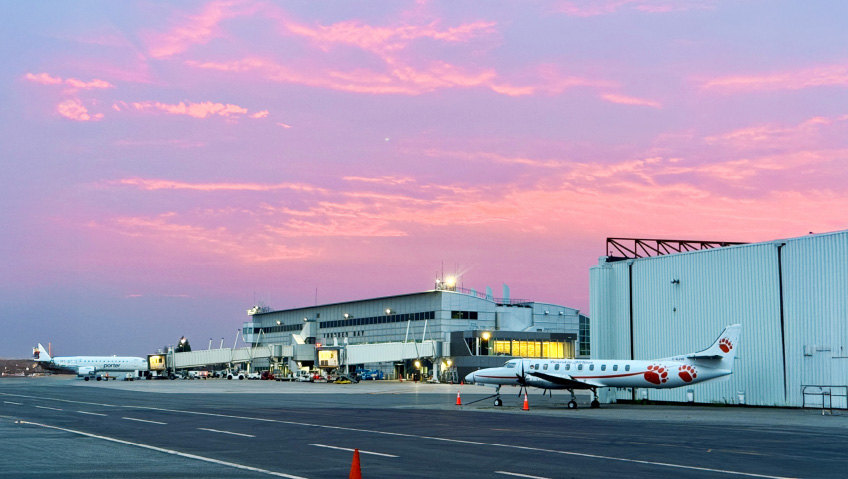Just like the 700,000-plus passengers that hurry through its doors each year, Thunder Bay International Airport is on a mission: to position itself as the premier airport in Northern Ontario.
Air Canada, Porter Airlines, WestJet, and Flair Airlines (seasonally) account for 80 percent of passenger traffic while Bearskin Airlines, North Star Air, and Wasaya Airways provide vital service to northern First Nations communities. Ridership continues to grow since the lows of the pandemic, as has the airport’s investment in serving its customers and its community.
With determination, a commitment to innovation, and collaboration with the city of Thunder Bay and Indigenous partners in the region, the Thunder Bay International Airport is fulfilling a three-year strategic plan that will transform the airport’s operation and brand, as well as its role as an economic driver in the region.
Ready for takeoff
In April 2024, the airport came under new leadership with Graham Ingham assuming the role of President/CEO, and with this change came new energy, enthusiasm, and a path forward.
“When an organization experiences a change of leadership, with that comes a revitalization of mission, vision, values, and priorities which feed our goals for the duration of the strategic plan—in this case, for three years,” explains Ryan Brading, Director of Airport Operations under the airport’s new three-year strategic plan that came into effect on January 1, 2025. The strategic plan establishes a framework to shape and guide operational improvements, investments, and management practices toward clearly defined and measurable goals, leading to a complete re-brand that better embodies these strategic intentions.
The new brand, inclusive of a new logo, was unveiled during Thunder Bay’s inaugural drone show in partnership with the City of Thunder Bay, which highlights an example of how the airport is working with the city to be a true community partner. Designed to reflect not only the airport’s contributions but also the beauty, culture, and heritage of Northwestern Ontario, the new brand serves as an ode to the region—its nature, its people, and its rich traditions—while emphasizing the importance of involving the community and shaping its identity.
Director of Business Development Jackie MacDonald notes, “Instead of carrying forward a corporate logo, we wanted our brand to embody our role as a community partner and highlight our deep connection to Northwestern Ontario and the North. Our new identity reflects the region’s natural beauty, rich culture, and the enduring spirit of travel.”
Expanding the runway to success
The growth and improvements that are being instituted at the Thunder Bay International Airport in accordance with the strategic plan focus on five target areas: driving economic development, ensuring operational excellence, championing environmental sustainability, fostering community and Indigenous partnerships, and investing in its workforce.
The plan is multifaceted and promises to impact the operation and culture of the airport while fostering the growth in size and vitality of the community of Thunder Bay and the many Indigenous communities it serves. The overarching goal of these efforts is to become a regional hub from which economic strength and partnership flow and to establish Thunder Bay International Airport as the premier aviation gateway and key economic driver for Northern Ontario.
Growth of the airport, in this case, means not only expanded routes, carriers, and increased passenger numbers, but also unique opportunities to leverage non-aeronautical revenue streams through retail and real estate opportunities on the property.
“We currently have about 47 hectares of developmental area that’s available and shovel ready, 20 of those hectares being airside development, such as FBOs, airside maintenance and repair, and aircraft hangars,” says MacDonald. The remaining lands are earmarked for light industrial uses like logistics, transportation and cargo, and commercial and retail opportunities like hotels and restaurants.
A leading aviation planning and engineering firm was retained to conduct a comprehensive feasibility study of the available land, which confirmed its suitability for strategic development and diversification. “Diversifying our revenue to include non-aeronautical streams is important because it makes airports less dependent on airline traffic, as we know from COVID and our experience of recovering and rebounding from that. It also supports growth by tracking investment, enhancing passenger services, and positioning ourselves as a stronger community and economic hub.”
MacDonald explains that this drives growth and additional tax revenue for the city and promises more sustainable growth for the airport in the long term.
Future-focused investments
In addition to optimizing land use—and thus, revenue growth—the airport will continue to make necessary upgrades to capacity and amenities in accordance with the strategic plan to increase passenger satisfaction and loyalty and strengthen the regional transportation network and tourism industry through a focus on enhanced operational efficiency, safety, and security.
To achieve this, the Thunder Bay International Airport is also investing significantly in modernizing the airport infrastructure, which includes projects to improve the terminal, airside infrastructure, and parking and roadways. There is also the implementation of a robust risk management and maintenance program that will extend the life of the airport’s assets, minimize downtime and related costs, and maximize return on investment.
From expanded runway infrastructure—which will improve safety for large, narrow-bodied aircraft—to check-in counters equipped with updated technology and Indigenous art that reflects the region and the brand, this complex project effectively represents a complete makeover that will position the operation well for the long term. For Brading, it is a matter of “aligning the airport’s strategies with a revitalized vision of where we want to be in the future and making sure that we’re doing so in alignment with best practices and ever-changing regulatory compliance,” he says.
“The [Canadian Aviation] regulations are changing almost as fast as we can keep up, which emphasizes the importance of ensuring we’re moving forward with a solid plan, a vision, and a clear path to get to where we need to be.”
Sustainability, for instance, is not only important from an economic perspective, but also from an environmental one. The Thunder Bay International Airport seeks to be a good steward and champion of environmental sustainability by minimizing its impact, which will be achieved through emissions reductions, improved waste diversion, and other eco-friendly initiatives that will measurably affect future generations for the better.
Strengthening relationships is another significant part of the pillar of sustainability. This is especially true of the airport’s desire to be an employer of choice in the community, one that is committed to creating a positive, diverse, and highly skilled workforce to replicate its success time and again. In this case, success can be measured by the satisfaction of employees, passengers, and partners alike, and to continue to be successful, investments have been made in employees’ growth, well-being, and professional development.
Referring to the employees of the airport as the “engine of the organization,” Ingham notes that investing in its people and its capacity as an employer helps the airport to “make sure that our people have the resources and the tools to do the job and to help support our new direction through our strategic business plan. At the end of the day, we want to be recognized as a great place to work.”
A strong business case
As with any business, the goal of all this collaboration, of so many strands coming together, is to be profitable by growing revenue in the long term, which includes expanding services for passengers as well as optimizing land utilization on the property to better integrate those services for the benefit of local communities.
“That’s really important, not only from the airport’s perspective, but also from the community’s perspective, because with that comes jobs, with that comes tax revenue for the city of Thunder Bay, and also a stable and reliable source of income,” says Ingham. He believes the new developments should insulate the airport from any repeat pandemic-like interruptions to service.
Furthermore, the strategic plan serves as a strong succession planning tool to ensure that knowledge transfer and the structural and organizational changes that have taken place are entrenched in the airport’s culture as it grows.
Looking ahead, efforts will continue to be made to strengthen regional and global connectivity by securing new routes (with at least one route serving the U.S. to optimize competitiveness) and finding new ways to enhance the airport’s level of service delivery and its reputation in the market. We’ll be looking forward to clear skies ahead as this regional travel and economic hub takes off.






